Living with sciatica can be a painful experience and the longer you ignore the pain the worse it is going to get. In order to get sciatic nerve treatment you should start doing sciatica exercises to relieve pain from irritation on the sciatic nerve in your lower back and buttocks.
The best exercises that you can do to get quick relief from your sciatica are going to include rotating and stretching your hip away from your body.
Sciatica Exercises To Relieve Pain
To get a better idea about what is going on inside your body that is causing your sciatica, check out my post about common sciatica symptoms and treatment. Starting a regular vinyasa yoga practice will allow your body to build strength from within and heal the joints and muscles that are causing compression on your sciatic nerve.
If you’re looking for some quick relief, I recommend starting with the following exercises:
1. Figure 4 Pose
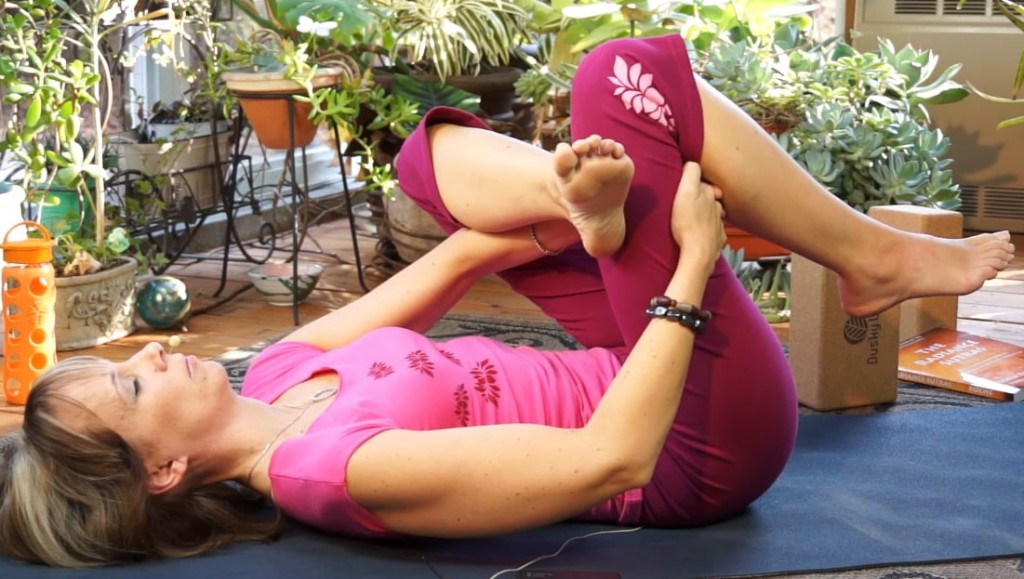
- While lying on your back, bend your knees so your feet are planted on the ground in front of you.
- Lift your right leg and place your ankle across your left leg just below your knee.
- Slowly begin to press your right knee away from your body until you feel the stretch in your right hip.
- Hold this stretch for a few breaths and then switch legs.
2. Pigeon Pose
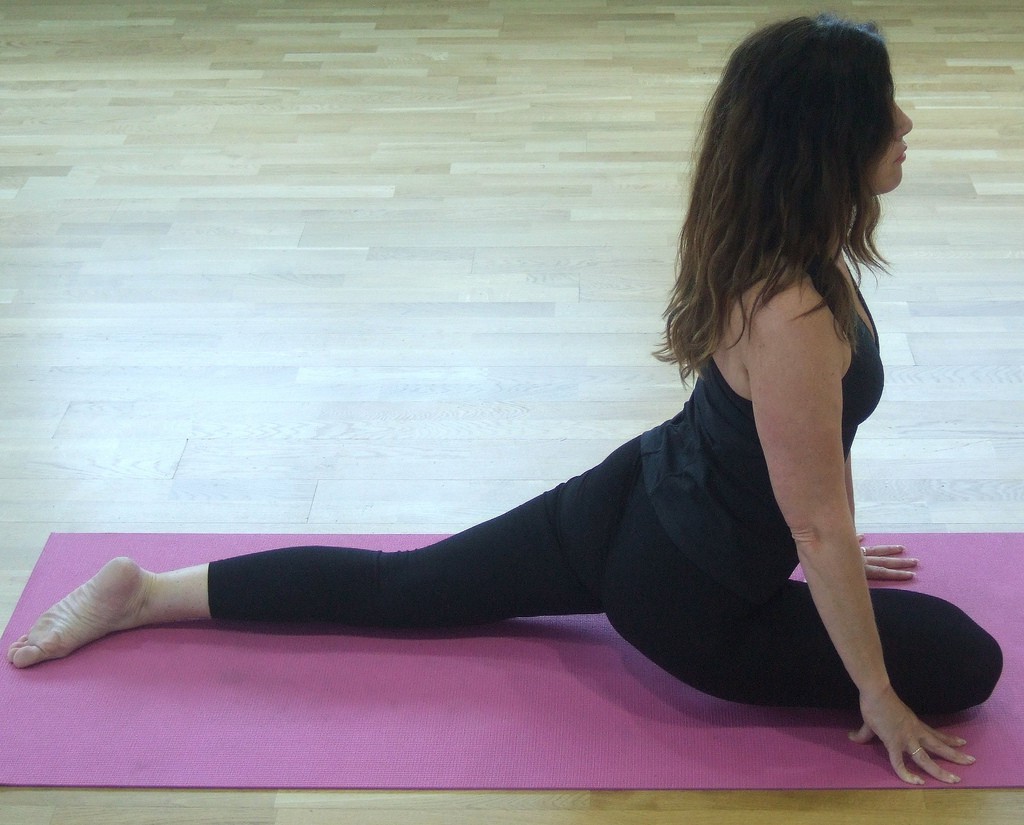
- Start with your hands and knees on the ground in a table-top position.
- Bring your right knee towards your right hand and your right foot towards your left hand.
- Begin to straighten your left leg out behind you while moving your left thigh and right hip towards to floor.
- Slowly lean forward and bring your forearms and head to touch out in front of you.
- Hold for a few breaths and then switch sides.
3. Seated Twist
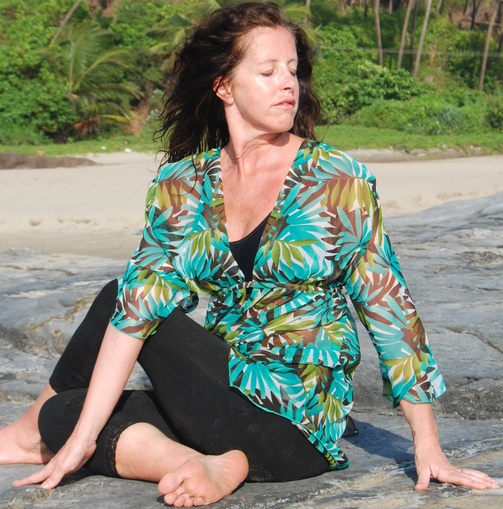
- While in a seated position with your legs out in front of you, straighten you spine while bending your right knee and place your foot on the ground on the outside of your left knee.
- Rest your left elbow on your right knee and and your right hand on the ground beside you.
- Slowly begin to pull your right knee towards you with your left hand while looking and twisting your body to the right.
- Hold for a few breathes, going deeper into the stretch each time you exhale, and then switch sides.
4. Reclining Angle Pose (Supta Baddha Konasana)
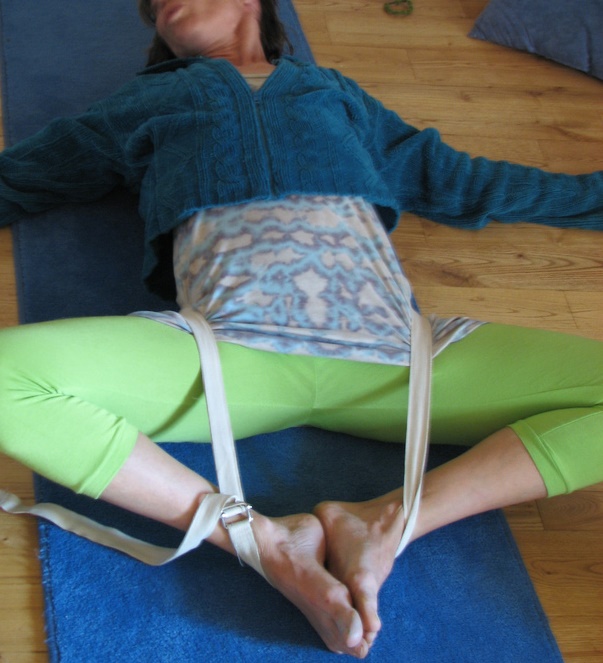
- While lying on your back, bend your knees and bring the soles of your feet to touch in front of you.
- Place your hands near the creases of your hips and gently begin to press your hips forward with your hands.
- Allow your knees to spread wide and fall towards the ground on both sides.
Get Sciatic Nerve Treatment With Yoga
Consistently stretching your hips and lower back will allow space to open up around your sciatic nerve and loosen the muscles that are causing tightness in your lower back. Stretching and strengthening the muscles and joints around your sciatic nerve will begin to heal weakened tissue that has allowed for compression of the nerve.
I strongly recommend that you start a consistent yoga routine if you are serious about getting long-term relief from your sciatic pain.
I have personally experienced sciatica and chronic low back pain for years and yoga is the only exercise that has allowed for my body to strengthen from the inside out. There is hope for sciatica relief without the use of surgery or pain pills but it is going to take a lot of hard work and dedication to do so but I think living without the pain is worth it, don’t you?
How do you find relief from your sciatica?
Stick With It!


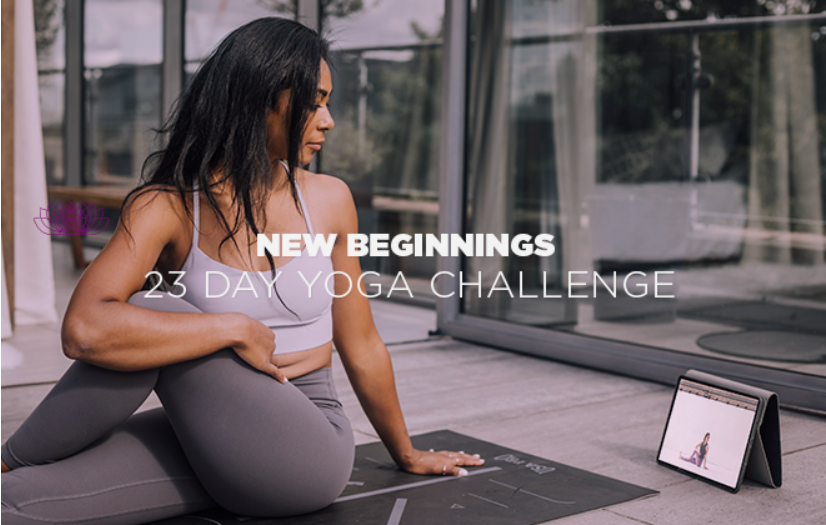
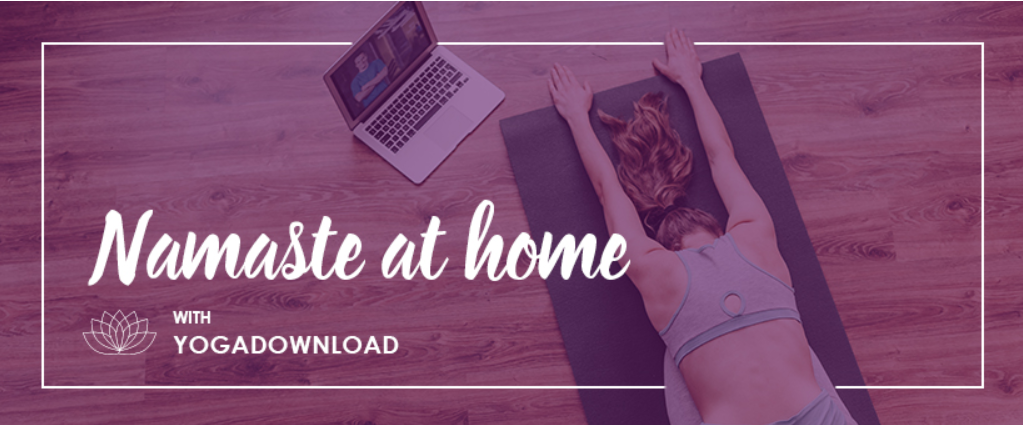
Hello, I’ve been reading your website for quite some time now and I really like it! It seems that you are very passionate about yoga and you really want to share your knowledge with others!
My mom is suffering from lower back pains for a really long time now. I’m going to show your blog to her, hopefully it helps.
Greetings from Lithuania!
Hello Julius! I’m so happy that you like what you are reading! The reason I am so passionate about yoga is because I know how much it has helped me and my own low back pain so I just want to help as many people as possible who are suffering from the same condition.
I hope your mom is able to find some relief from her pain soon, I know how difficult it can be trying to live with chronic low back pain.
Thanks for the comment all the way from Lithuania!
the primary cause of sciatica is herniated disc. There are also people who suffer from bulging disc so that the bulged disc irritates the nerve and causes sciatica, but this is not common. Although bulging disc usually does not cause the pain, but the way that it changes to the disc herniation is very short. Number of bulging disc people is much larger than those with a herniated disk, but because it is painless, so people do not know to prevent. Bulging disc hides a huge risk, but the good information is that it can be cured completely by normal therapy (chiropractic method, hanging on pull up bar, swimming..). Conversely, a herniated disc can not recover completely in the current medical condition – they have no effective way to “patch” the torn annulus fibrosus. Because the annulus fibrosus has torn so it can not keep the nucleus pulposus inside: Although the herniated mass has been removed by surgery or returned to its former position by chiropractic method, but if the patients subjectively (think that the disease is healed completely) don’t conserve the health, the disease will recur again, even more serious. Thus, treatment of disc herniation is a long and arduous process – the patients must live with it, accept it, patiently conserve and exercise to the disease becomes gradually better and does not relapse
Treatment of herniated disc is divided into two main methods: conservative treatment (no surgery – makes up 90% of cases of herniated disc) and surgery. Surgery is the last resort, when the volume of herniated mass is too large and compress seriously on the nerve roots or spinal cord can cause the patient to be completely paralyzed – at that time surgery is required emergency to rescue the patients. But the case of mild herniation, the doctor will recommend conservative treatment, never appoint the surgery, because the surgery contains a lot of risks and complications during surgery performance and after surgery.
Conservative treatment is a very long way, attached to the patient from the first day of having herniated disc to the end of life. When beginning to suffer from herniated disc, the patient must perform “the cure”. When the pain ends, the patient must “prevent recurrence”. In both phases of conservative treatment (“cure” phase and “relapse prevention” phase), hanging on the pull up bar to stretch the spine is very necessary and effective:
+ In the “cure” phase: For patients newly have herniated disc, or have herniated disc for a time but at mild and medium level, or suffer from bulging disc, hanging on pull up bar help stretch the spine naturally thereby reduce the compression of the vertebrae on the herniated disc (or bulged disc). Nucleus pulposus is soft gel, when pinched it leak out (hernia) or make the disc bulge (bulging disc) – but when there is no compression it shrink naturally into original position. Therefore, hanging on pull up bar (or stretching the spine) will help the nucleus pulposus come back into annulus fibrosus, since then there are no longer irritations on nerves or spinal cord, the patient will not feel the pain and numbness. There are patients with bulging disc, only hanging on pull up bar regularly make the disease be completely healed.
+ In the “relapse prevention” phase: Hanging on pull up bar daily will help back muscles and abdominal muscles become strong, thereby supporting the spine a lot in bearing the body weight, reducing pressure on the discs. Each time hanging on pull up bar is the chance to reduce the compression on the disc, help nucleus pulposus to be at its normal position, no bulges or herniations occur. Many people place the pull up bar near the workplace or the bed for ease of daily exercise. When working, they stand up to hang on the pull up bar after 1 hour of sitting (4-5 times, each time for 15 seconds). Before going to bed they hang on the bar, then lie down immediately to maintain the stretched state of the spine and go to sleep.
The patient must always be aware that they are “not healed completely” to exercise assiduously, take care of the health, protect the spine. On the other hand, because the pull up bar is extremely necessary tool in conservative treatment, and attached to the patient for whole life, so each patient of herniated disc /sciatica should be equipped a safety and high quality pull up bar – should not disregard.
Hello and thanks for your in depth description of sciatica!
When I first started practicing yoga to help with the herniated disc in my lower back I also did exactly as you said and hung from a pull-up bar as often as possible because I could feel it stretching my spine and the relief I felt was immediate. Adding yoga to strengthen the muscles around my lower lumbar in addition to stretching out the vertebrae has “cured” my sciatica because I no longer feel numbness or pain in my lower back or legs.
But you are definitely correct in saying that it is not a quick fix and it has taken me over a year to feel the relief I now have and if I don’t keep up my regular practice the irritation slowly starts to come back. Thanks for the comment!
Thank you so much for this valuable information.
It is people like you that really make a difference in the lives of people with sciatica.
I suffered for 20 years from sciatica and nothing I tried worked.
It was a struggle to get a good night’s sleep and It got to the point where tying my own shoe laces had become a painstaking 10 minute task.
I tried pills, injections, special mattresses, you name it…but nothing worked for too long.
Fortunately, I found out about a natural way that finally got rid of my sciatica for good.
This article talks about it…
http://www.healthwise101.com/sciatica-treatment
Hope it helps and keep up the good work!